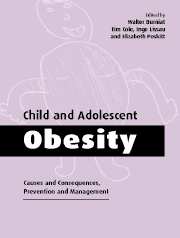Book contents
- Frontmatter
- Contents
- List of contributors
- Foreword
- Preface
- Part I Causes
- 1 Measurement and definition
- 2 Epidemiology
- 3 Molecular and biological factors with emphasis on adipose tissue development
- 4 Nutrition
- 5 Physical Activity
- 6 Psychosocial factors
- Part II Consequences
- Part III Prevention and management
- Index
4 - Nutrition
Published online by Cambridge University Press: 02 November 2009
- Frontmatter
- Contents
- List of contributors
- Foreword
- Preface
- Part I Causes
- 1 Measurement and definition
- 2 Epidemiology
- 3 Molecular and biological factors with emphasis on adipose tissue development
- 4 Nutrition
- 5 Physical Activity
- 6 Psychosocial factors
- Part II Consequences
- Part III Prevention and management
- Index
Summary
Introduction
Nutrition is a major determinant of body size (Forbes, 1962). In addition to the energy intake from food, other components, such as the balance of nutrients in the diet and the diurnal pattern of food consumption, have been related to body composition.
Some studies describe trends in nutritional intake and obesity over time. Others analyse associations between food intake and body weight status but the available information is not always easy to interpret. Most results derive from dietary surveys, which remain the main method for determining the intakes of large populations. The limitations of dietary surveys, particularly under-reporting by obese subjects, have been widely discussed. One reason, apart from the difficulties of data collection on diets, why the interpretation of nutritional data is often difficult in obesity, could be that the present nutritional intake of obese subjects is not the factor responsible for development of the obese constitution. Indeed, dietary restriction in obese adults is frequently reported (Ballard-Barbash et al., 1996). In children, however, dietary data should be more promising, because the current behaviour of obese children is closer than adult behaviour to the spontaneous obesity-promoting intake.
In the present chapter, we discuss the significance of data on food intake for obesity in children and try to identify the nutritional and/or behavioural factors, which promote obesity.
- Type
- Chapter
- Information
- Child and Adolescent ObesityCauses and Consequences, Prevention and Management, pp. 69 - 92Publisher: Cambridge University PressPrint publication year: 2002
- 6
- Cited by



